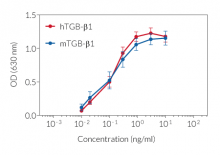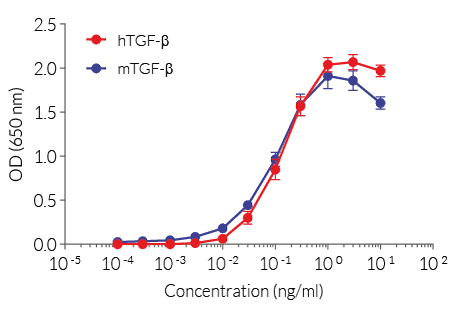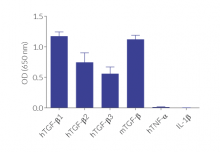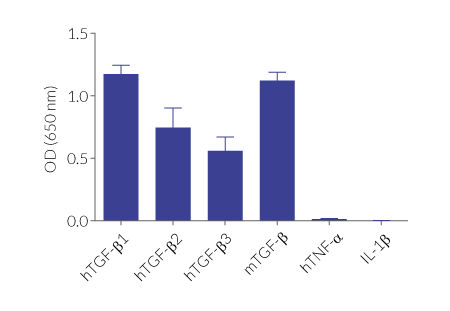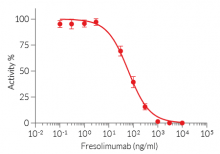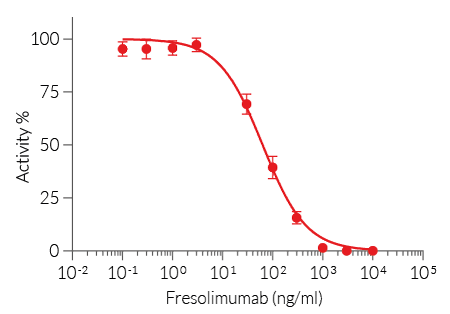TGF-β Reporter HEK 293 Cells
| Product | Unit size | Cat. code | Docs. | Qty. | Price | |
|---|---|---|---|---|---|---|
|
HEK-Blue™ TGF-β cells Human & Mouse TGFβ SEAP Reporter Cells |
Show product |
3-7 x 10e6 cells |
hkb-tgfbv2
|
|
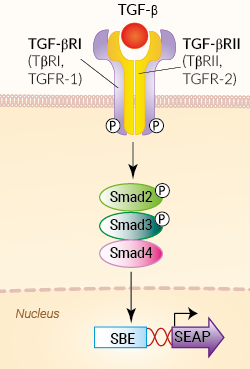
HEK-Blue™ TGF-β Cells signaling pathway
TGF-β Reporter Cells
HEK-Blue™ TGF-β cells were engineered from the human embryonic kidney HEK 293 cell line to detect bioactive human and murine transforming growth factor-beta (TGF-β) by monitoring the activation of the TGF-β/Smad pathway. These cells can also be used for screening anti‑TGF-β antibodies using flow cytometry. TGF-β regulates numerous cellular functions, such as cell proliferation, apoptosis, differentiation, and migration [1,2].
Cell line description:
HEK-Blue™ TGF-β cells were generated by stable overexpression of a Smad-inducible secreted embryonic alkaline phosphatase (SEAP) reporter. The binding of TGF-β to its receptor on the surface of HEK‑Blue™ TGF-β cells triggers a signaling cascade leading to the formation of a Smad3/Smad4 complex. The heterocomplex enters the nucleus and binds SBE sites inducing the production of SEAP. This can be readily assessed using QUANTI-Blue™ Solution.
Features of HEK-Blue™ TGF-β cells:
- Fully functional TGF-β signaling pathway
- Readily assessable SEAP reporter activity
- The stability for 20 passages has been verified
- Functionally tested and guaranteed mycoplasma-free
Applications of HEK-Blue™ TGF-β cells:
- Detection of human and murine TGF-β (10 pg/ml - 10 ng/ml)
- Screening of anti-TGF-β antibodies
References:
1. Travis MA. & Sheppard D., 2014. TGF-β activation and function in immunity. Annu Rev Immunol. 32:51-82.
2. Taylor AW., 2009. Review of the activation of TGF-beta in immunity. J Leukoc Biol. 85(1):29-33.
Specifications
Antibiotic resistance: Zeocin®
Growth medium: DMEM, 4.5 g/l glucose, 2-4 mM L-glutamine, 10% (v/v) fetal bovine serum, 100 U/ml penicillin, 100 μg/ml streptomycin, 100 μg/ml Normocin™
Specificity: human and murine TGF-β
Detection range:
- 10 pg/ml - 10 ng/ml for hTGF-β
- 10 pg/ml - 10 ng/ml for mTGF-β
Quality Control:
- SEAP reporter activity in response to human and murine TGF-β has been validated.
- The stability for 20 passages, following thawing, has been verified.
- These cells are guaranteed mycoplasma-free.
This product is covered by a Limited Use License (See Terms and Conditions).
Back to the topContents
- 3-7 x 106 HEK-Blue™ TGF-β cells in a cryovial or shipping flask
- 1 ml of Zeocin® (100 mg/ml)
- 1 ml of Normocin™ (50 mg/ml)
- 1 ml of QB reagent and 1 ml of QB buffer (sufficient to prepare 100 ml of QUANTI-Blue™ Solution, a SEAP detection reagent)
![]() Shipped on dry ice (Europe, USA, Canada and some areas in Asia)
Shipped on dry ice (Europe, USA, Canada and some areas in Asia)
Details
Tumor growth factor-beta (TGF-β) belongs to a family of structurally related cytokines that regulate a plethora of cellular functions, such as proliferation, apoptosis, differentiation, and migration [1,2]. TGF-β exists in at least three isoforms; TGF-β1, TGF-β2, and TGF-β3. In the immune system, TGF-β1 is the predominant isoform [1]. It is produced by many cell types, including macrophages, in a latent form that is bound to two other polypeptides, latent TGF-β1 binding protein (LTBP) and latency-associated peptide (LAP). Upon cleavage of these proproteins, the mature TGF-β1 is released. This mature protein can bind its cell surface receptors and initiate signaling.
TGF-β binds to type II receptors (TβR-II) which recruit and activate type I receptors (TβR-I). The active ligand-heterotetrameric receptor complex signals through downstream transcriptional factors named Smads, including Smad2, Smad3, and Smad4.
Smad complexes translocate into the nucleus where they regulate the transcription of target genes, which contain one or more Smad binding elements (SBEs) in their promoter region [3]. Perturbations in TGF-β signaling affect immune homeostasis and tolerance, leading to inflammatory diseases and tumor immune evasion [3].
1. Travis MA. & Sheppard D., 2014. TGF-β activation and function in immunity. Annu Rev Immunol. 32:51-82.
2. Taylor AW., 2009. Review of the activation of TGF-beta in immunity. J Leukoc Biol. 85(1):29-33.
3. Battle E. & Massagué J., 2019. Transforming Growth Factor-beta Signaling in Immunity and Cancer. Immunity. 50(4):924.





